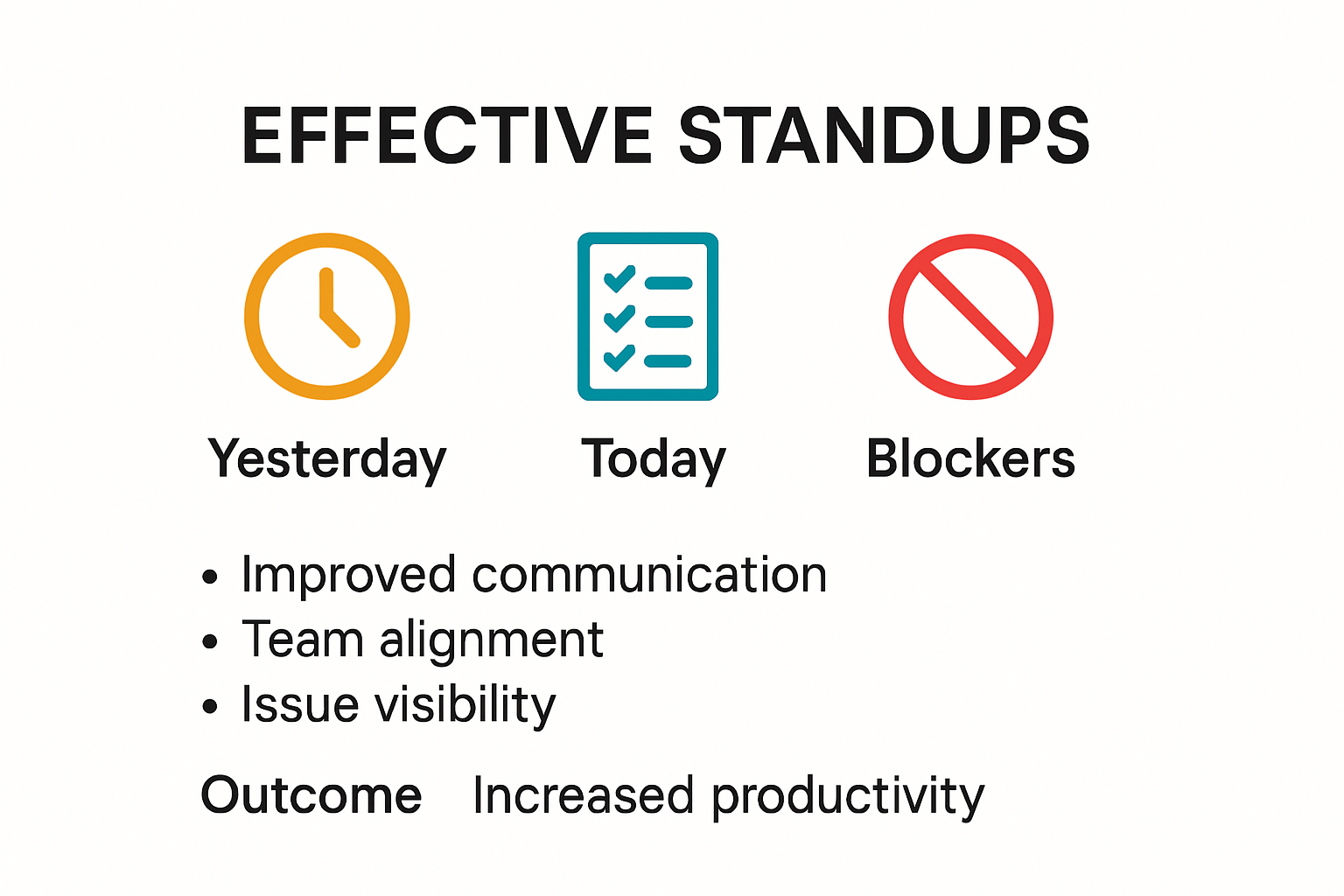Daily standups can feel routine and even frustrating after a few months. Most teams think that gathering everyone for a quick sync is the fastest way to solve problems and stay aligned. But statistics show that poorly run standups can actually decrease job satisfaction and erode team trust, all while wasting time. The real secret is that keeping meetings under 15 minutes and making every voice heard leads to better results than any fancy agenda ever could.
Table of Contents
- Understanding The Purpose Of Daily Standups
- Setting Up Effective Standup Meeting Structures
- Best Practices For Engaging Your Team
- Common Pitfalls And How To Avoid Them
Quick Summary
| Takeaway | Explanation |
|---|---|
| Keep meetings under 15 minutes | Limit standup duration to boost focus and efficiency, encouraging concise updates from team members. |
| Foster a safe communication environment | Create a culture where everyone feels comfortable sharing challenges and ideas without judgment, enhancing collaboration. |
| Establish clear speaking roles | Designate roles like speaker, timekeeper, and note-taker to streamline the meeting and hold participants accountable. |
| Use structured meeting formats | Choose suitable formats like Round Robin or Walking the Board to facilitate engagement and interaction among team members. |
| Address blockers proactively | Encourage team members to suggest solutions for obstacles during standups, transforming meetings into collaborative problem-solving sessions. |
Understanding the Purpose of Daily Standups
Daily standups are a critical communication ritual in modern team management, designed to create transparency, alignment, and rapid problem resolution. These brief, focused meetings serve as a powerful mechanism for teams to synchronize efforts, identify potential roadblocks, and maintain collective momentum.
Why Daily Standups Matter for Team Performance
Teams adopting daily standups experience significant improvements in communication and collaboration. Research from the University of Strathclyde reveals seven key benefits: enhanced communication, increased collaboration, time savings, continuous improvement, clear decision-making, common goal alignment, and team success celebration.
The primary objective of a daily standup is not merely to report status but to create a consistent rhythm of communication. Each team member shares three fundamental pieces of information: what they completed yesterday, what they plan to accomplish today, and any obstacles blocking their progress. This structured approach ensures everyone understands the team’s current trajectory and can offer immediate support when challenges emerge.
Potential Challenges in Implementing Effective Standups
Research published in Emerald Insight highlights that while stand-up meetings enhance communication and collaboration by fostering team trust, they can also present implementation challenges. Teams must be intentional about maintaining the meeting’s focus and avoiding conversational drift.
A critical warning comes from a study on arXiv, which notes that poorly conducted daily standups can negatively impact job satisfaction and team trust. This underscores the importance of having a clear structure, time limit, and facilitator who can keep the meeting on track.
Optimizing Daily Standup Effectiveness
To maximize the value of daily standups, leaders should establish clear guidelines. Meetings should typically last no more than 15 minutes, with each team member speaking for approximately 1-2 minutes. The focus must remain on coordination and problem-solving, not detailed status reports.
Successful daily standups create a predictable, supportive environment where team members feel comfortable sharing challenges and seeking collective solutions. By transforming these brief meetings from mere status updates to dynamic problem-solving sessions, organizations can significantly enhance team productivity and cohesion.


Setting Up Effective Standup Meeting Structures
Designing an effective standup meeting structure requires careful planning and intentional strategies to maximize team communication and productivity. The right approach can transform these brief daily gatherings from routine check-ins to powerful collaboration opportunities.
Choosing the Right Standup Meeting Format
Pluralsight highlights five distinct standup meeting structures that teams can adopt based on their specific needs and dynamics. These formats provide flexibility in how team members share updates and engage with one another:
- Round Robin: Participants share progress reports sequentially, ensuring everyone gets an equal opportunity to speak.
- Walking the Board: Ideal for teams using Scrum or Kanban boards, where members review each task systematically.
- Popcorn Style: Participants choose the next speaker, which works particularly well for remote teams and encourages organic interaction.
- Token Passing: An object is passed to indicate the current speaker, creating a structured yet dynamic communication flow.
- Card-Based Selection: Team members select numbered cards to determine speaking order, introducing an element of randomness.
Below is a table summarizing the different standup meeting formats and their key characteristics to help you choose the most suitable one for your team.
| Format | Description | Best For |
|---|---|---|
| Round Robin | Sequential sharing by every participant | Equitable participation |
| Walking the Board | Review tasks directly from the board in order | Scrum/Kanban teams |
| Popcorn Style | Current speaker chooses the next; order is organic | Remote or distributed teams |
| Token Passing | An item indicates the current speaker; passed around the group | Dynamic, interactive teams |
| Card-Based Selection | Team members draw/select numbered cards to determine speaking order | Teams seeking randomness |
Time Management and Meeting Efficiency
TechTarget emphasizes the critical importance of keeping standup meetings concise. Their research recommends limiting meetings to 10 minutes or less to maintain productivity. This time constraint requires participants to be precise and focused in their updates.
The frequency of standup meetings should also be flexible. While daily meetings are common, not all teams require this level of frequent communication. Leaders should assess their team’s workflow, project complexity, and communication needs to determine the most appropriate meeting cadence.
Role Distribution and Responsibility
The Scrum Institute provides detailed guidance on role distribution during standup meetings, ensuring structured and effective communication:
- Speaker Role: Responsible for providing concise updates on accomplishments, immediate plans, and potential impediments.
- Timekeeper Role: Monitors and ensures the meeting stays within the allocated time frame, preventing unnecessary discussions.
- Note-Taker Role: Captures key discussion points, tracking progress, challenges, and action items for future reference.
The following table provides a clear overview of the common standup meeting roles and their responsibilities.
| Role | Responsibility |
|---|---|
| Speaker | Share succinct updates on completed work, daily goals, and any blockers |
| Timekeeper | Ensure meeting adheres to time limits; reign in off-topic discussions |
| Note-Taker | Document action items, blockers, and key decisions for team reference |
By implementing these structured approaches, teams can transform daily standups from mundane status updates into dynamic, collaborative sessions that drive project momentum and team alignment. The key is to remain adaptable, continuously refine the process, and prioritize meaningful communication over rigid adherence to a single format.
Best Practices for Engaging Your Team
Engaging team members during daily standups requires more than just following a prescribed format. It demands creating an environment of trust, open communication, and genuine collaboration that motivates every participant to contribute meaningfully.
Creating a Safe Communication Environment
Research from HR Fraternity emphasizes the critical importance of fostering a culture of open communication during daily standups. The key is creating an atmosphere where team members feel psychologically safe to express their thoughts without fear of judgment or criticism.
This safety manifests through active listening, non-confrontational body language, and a genuine commitment to understanding each team member’s perspective. Leaders must demonstrate vulnerability by sharing their own challenges and acknowledging that obstacles are opportunities for collective problem-solving, not individual failures.
Innovative Engagement Techniques
A research study published in 2021 introduces an exciting approach to making daily standups more interactive by integrating design thinking techniques. These methods transform routine meetings into dynamic collaboration sessions through strategies like:
- User Research Integration: Encourage team members to share insights from direct user interactions
- Ideation Moments: Allow brief brainstorming sessions around current project challenges
- Rapid Prototype Discussions: Share quick visual representations of ongoing work
Preparation and Follow-up Strategies
Planday suggests that effective engagement begins before the meeting starts. Allocating a few minutes for team members to organize their thoughts ensures more structured and productive discussions. This preparation time allows participants to:
- Reflect on their previous day’s accomplishments
- Identify potential roadblocks
- Formulate clear, concise updates
Equally important is establishing a robust follow-up mechanism. Assign a dedicated note-taker to capture action items, track progress, and ensure that discussion points translate into tangible outcomes. This approach demonstrates that the standup is not just a ritual but a meaningful platform for collaborative problem-solving.
By implementing these strategies, leaders can transform daily standups from mundane status updates into energetic, purpose-driven meetings that genuinely move projects forward. The goal is not just communication but meaningful connection that empowers team members and drives collective success.
Common Pitfalls and How to Avoid Them
Daily standup meetings, while designed to enhance team communication and productivity, can quickly become ineffective if not carefully managed. Understanding and proactively addressing common challenges is crucial for maintaining the meeting’s value and team engagement.
Meeting Structure and Time Management Challenges
Research from Hogonext reveals several critical pitfalls that can derail standup effectiveness. One of the most significant issues is the tendency for meetings to devolve into lengthy monologues, where team members provide excessive detail or engage in unnecessary discussions.
To combat this, leaders should implement strict time management strategies. Use a timer to enforce a maximum of 1-2 minutes per participant, and establish a clear protocol for parking complex discussions for later. Rotating meeting facilitators can also help maintain discipline and prevent any single team member from dominating the conversation.
Communication and Engagement Barriers
According to Standup Alice, common communication mistakes can significantly undermine the standup’s effectiveness. These include:
- Vague Updates: Team members providing unclear or superficial progress reports
- Problem-Solving During Standup: Attempting to resolve complex issues in real-time
- Lack of Focus: Allowing conversations to drift from the core update format
To address these challenges, establish clear guidelines for updates. Encourage team members to structure their sharing around three key points: completed tasks, planned work, and potential blockers. Implement a ‘parking lot’ method where complex problems are noted for separate, focused discussions.
Addressing Blockers and Maintaining Momentum
Attendancebot highlights the critical importance of effectively handling obstacles and maintaining team momentum. The key is not just identifying blockers but creating a proactive resolution mechanism.
Encourage team members to not only mention challenges but also suggest potential solutions or identify who might help resolve the issue. This approach transforms the standup from a mere reporting session into a collaborative problem-solving opportunity. Before the meeting concludes, ensure there’s clarity on the next steps for each identified blocker.
Successful daily standups require continuous refinement. Regular team feedback, willingness to adapt the meeting format, and a commitment to maintaining the meeting’s core purpose of quick, meaningful communication are essential. By anticipating and addressing these common pitfalls, teams can transform daily standups from potential time-wasters into powerful tools for alignment and productivity.
Frequently Asked Questions
What are daily standups and why are they important?
Daily standups are brief, focused meetings designed to synchronize team efforts, identify roadblocks, and maintain momentum. They enhance communication, collaboration, and decision-making within teams.
How long should daily standup meetings last?
Daily standup meetings should typically last no more than 15 minutes to maintain focus and efficiency. This encourages concise updates from each team member.
What are effective formats for conducting daily standups?
Popular formats for daily standups include Round Robin, Walking the Board, Popcorn Style, Token Passing, and Card-Based Selection. Each format offers different ways for team members to engage and share updates.
How can I keep my team engaged during daily standups?
To keep your team engaged, create a safe communication environment, encourage participation, and implement innovative engagement techniques like user research integration or ideation sessions. Preparation and follow-up strategies also enhance engagement.
Transform Your Standups Into Real Results With AI-Powered Team Management
Is your team struggling with standups that feel repetitive or unfocused? The article highlights how easily daily meetings can lose value when conversations drift or details fall through the cracks. Many leaders want to maintain a sharp 15-minute focus and ensure every voice feels heard, yet manual coordination and follow-up can quickly become overwhelming.

Imagine if your daily standups could run themselves with AI-assisted preparation, automated discussion tracking, and built-in follow-ups. Gammatica.com helps leaders do exactly that. By using features like Kanban boards, automated checklists, calendar syncing, and AI-generated action items, you can keep your standups fast, inclusive, and actionable. Integrate meeting tools such as Zoom or Google Meet, track blockers in real time, and find everything saved and organized for your team. Discover how much time and stress you can save by trying the Gammatica platform today. If you want meetings that spark engagement and turn talk into action, now is the time to see the difference for yourself.



